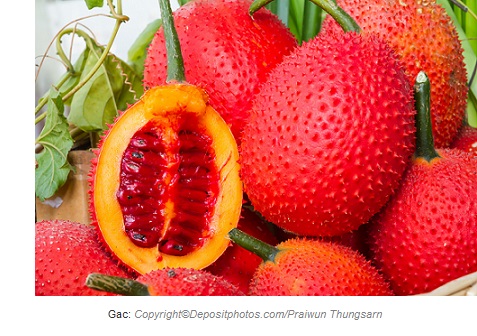Gac is a well-known fruit in Southeast Asia especially in Vietnam. It is sometimes  called “Baby Jackfruit”. The average weight of the fruit is 500 – 1500 grams. Every 100 grams of edible portion of the fruit contains 7 grams of carbohydrates, 0.6 gram of protein and 0.1 gram of fat, while every 100 grams of the pulp provides 10 grams of carbohydrates, 2 grams of protein, and 8 grams of fat. Gac is poor in fiber, 1.6 gram per 100 grams. The fat in gac is a combination of both saturated and unsaturated fats.
called “Baby Jackfruit”. The average weight of the fruit is 500 – 1500 grams. Every 100 grams of edible portion of the fruit contains 7 grams of carbohydrates, 0.6 gram of protein and 0.1 gram of fat, while every 100 grams of the pulp provides 10 grams of carbohydrates, 2 grams of protein, and 8 grams of fat. Gac is poor in fiber, 1.6 gram per 100 grams. The fat in gac is a combination of both saturated and unsaturated fats.
Average calories: 30 per 100 grams of the fruit, and 120 per 100 grams of the pulp.
|
Gac: 100 grams of edible portion |
|
|
Carbohydrate |
7 |
|
Fiber |
1.6 |
|
Protein |
0.6 |
|
Fat |
0.1 |
|
Calories |
30 |
|
Gac: 100 grams of the pulp |
|
|
Carbohydrate |
10 |
|
Fiber |
1.6 |
|
Protein |
2 |
|
Fat |
8 |
|
Calories |
120 |
Vitamins found in higher amounts: vitamins E, C, and A. Gac has vitamin C about 40 times more than oranges.
Minerals found in higher amounts: potassium, calcium, magnesium, and manganese.
Phytonutrients found in higher amounts and their health benefits: gac contains substantial amounts of lycopene, zeaxanthin, and beta-carotene, mainly concentrated in the pulp and seeds of the fruit. They are carotenoids with anti-oxidative and anti-cancer effects. Beta-carotene and zeaxanthin promote healthy vision and eyes, and lycopene supports healthy prostate gland.
Every one gram of gac contains:
– 2200 mcg lycopene, which is approximately 75 times more than tomatoes.
– 1600 mcg beta-carotene, which is 20 times more than carrots.
– 250 mcg zeaxanthin, which is 100 times more than carrots and 40 times more than yellow corn.

